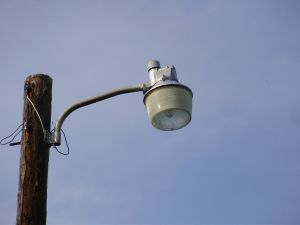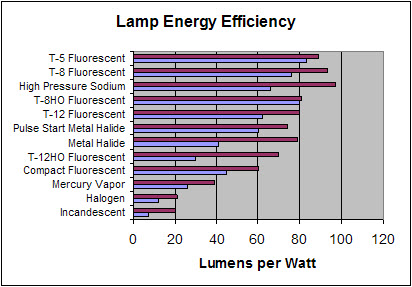Farm Lighting is part of a series of Efficiency Checklists and Topics that can help you to assess all areas of your farming operation for energy efficiency and find ideas to save energy and reduce costs. For links to other articles in the Efficiency Checklists and Topics series, see Additional Resources at the end of this article.
Farm Lighting
The design and management of a farm’s lighting system greatly affects its energy efficiency. Upgrading lighting fixtures will often give the best return on investment to reduce energy costs. Replacing older lamps with new energy-efficient lamps will reduce energy consumption and often improves the quality of the lighting.
Lighting efficiency is reported as lumens per watt or the light output per unit of energy used. Lamps that produce high lumens per watt will be most efficient. Use sunlight as often as possible; it will generally be the most efficient light available.
Incandescent bulbs should be replaced with compact fluorescent lamps (CFL) or an appropriate linear fluorescent lamp in most circumstances. Mercury vapor lamps can be replaced with high pressure sodium lamps, but if light quality is important, pulse-start metal halide lamps or linear fluorescent lamps might be a better choice. Refer to the chart below for the range of efficiencies for different lamp types.
Questions to ask:
- Are lights turned off if they are not needed?
- Are light fixtures kept clean?
- Can task lighting be used instead of general lighting for the job?
- Have you replaced incandescent bulbs with compact fluorescent lamps (CFLs)?
- Can high intensity discharge lamps (HID), pulse-start metal halide, high-pressure sodium, or T8 fluorescent lamp be used?
- Are lamps in the best location for the job?
- Would timers be beneficial in turning lights on and off?
- Would lights controlled with a motion sensor be a possibility?
- Do you dispose of old bulbs, lamps and ballast transformers properly?
Facts and Actions on Lighting
- Replace incandescent bulbs with CFLs for immediate savings – incandescent light bulbs are the least energy-efficient lighting available. An incandescent bulb that uses 100 watts of electricity can be replaced with a 23-watt CFL, which produces the same amount of light but uses more than 75% less energy. If you replace five 100-watt incandescent bulbs with five CFLs you can save $54.02 per year (based on $.10/KWh and 4 hours use per day). CFLs also have longer average life, lasting 6,000 to 10,000 hours vs. about 1,000 hours for an incandescent bulb. CFLs can be used outdoors in temperatures as low as -20 degrees F. (check label for ratings) but must be protected from moisture.
- Consider high intensity discharge (HID) lights, which consume 50% to 90% less energy than comparable incandescent bulbs, though they take several minutes to achieve rated intensity (turn on fully). HID lights are generally used to illuminate large areas, such as freestall barns or outdoor areas.
- Investigate new, more-efficient options to mercury vapor lights that have been historically used for security yard lighting. Mercury vapor lights produce 35 lumens per watt of power, while pulse-start metal halide lights emit 65 lumens per watt and high pressure sodium produce 90 lumens per watt. Many people opt for pulse-start metal halide lamps even though they are less efficient because they produce a light that has a truer color (higher color rendering properties) than the yellow light emitted by high-pressure sodium lamps.
- Install timers, photo sensors, and motion detectors to ensure that lights will be turned off during hours when they are not in use. They can be set to turn lighting on when it is dark or when there is motion and then turn off automatically when activity is less. Several companies make photo sensors with built-in clocks/timers for exterior lighting needs. Some types will turn the lamp off the second half of the night while others can be programmed to turn off and on at a set times (for example, off at 11 p.m. and on at 4 a.m.).
- Use motion sensors to turn on lights in areas when someone enters the room or there is motion outdoors. These sensors will turn off the lights after a period of time when no motion is sensed, eliminating unnecessary electrical usage. HID lamps cannot be used with motion sensors because they require several minutes to warm up and emit full output.
- Frequently switching lamps on and off will reduce lamp life.
- Prolonged exposure to moisture, such as in an enclosed building that houses animals, will reduce lamp life. Lamps installed in animal housing should be in fixtures with moisture resistant ratings.
- Clean dust off reflective surfaces of light fixtures to help maintain light output. Dust absorbs light waves and will reduce the output of lights. Dust also reduces heat transfer from transformers used on fluorescent and HID lamps, causing them to operate at elevated temperatures which will shorten transformer life.
- Provide spot lighting for work areas so you will need less higher wattage general lighting that can cost more to operate.
- If installing new fixtures, ask your lighting contractor or electrical wholesaler to provide a recommended spacing and layout based on the light fixtures you’re purchasing. The number of fixtures and the layout required depends on lamp wattage, the type and shape of refractor lens on the fixture, and on the area to be illuminated. Most manufacturers offer assistance for lighting design free of charge to dealers and installers.
- Dispose of lamps properly.
- All lamps except for incandescent and halogen lamps contain mercury; most states require them to be recycled.
- Some older ballast transformers from fluorescent or HID lamps contain PCBs, a substance that contaminates the environment. If the transformer doesn’t have PCBs, the manufacturer’s label will read “contains no PCBs” or “no PCBs”, and it can be disposed of in general trash. If that phrase is not located on the label, you must assume the ballast to be the PCB type, and it must be recycled or disposed of as hazardous waste by law.
Additional Resources
- Energy Efficient Agricultural Lighting by Scott Sanford, University of Wisconsin Cooperative Extension, provides tables and charts to help you determine if lighting is necessary and what types of lamps and fixtures are appropriate.
- What about Fluorescent Lighting? by Robert Grisso, Virginia Cooperative Extension.
- Choosing the Right Type of Light. by Scott Sanford, University of Wisconsin Cooperative Extension
- Dimmable Compact Fluorescent Lamps. Washington State University Energy Program.
Efficiency Checklist and Topics:
- Farm Energy Efficiency Checklist and Tips
- Farm Lighting Energy Efficiency Checklist and Tips
- Farm Shop Energy Efficiency Checklist and Tips
- Grain Drying Energy Efficiency Checklist and Tips
- Greenhouse Energy Conservation Checklist
- Home Energy Efficiency Checklist and Tips
- Irrigation Energy Efficiency Checklist and Tips
- Livestock Buildings Energy Efficiency Checklist and Tips
- Livestock Watering Systems Energy Efficiency Checklist and Tips
- Tractor and Field Operations Energy Efficiency Checklist and Tips
Contributors
This publication was adapted from the Farmstead Energy Audit, North Dakota State University Extension.
Author
- Carl Pedersen, Energy Educator North Dakota State University
Peer Reviewers
- Scott Sanford, Senior Outreach Specialist, University of Wisconsin – Madison
- Richard Beard, Associate Professor, Extension Agricultural Engineering, Utah State University


